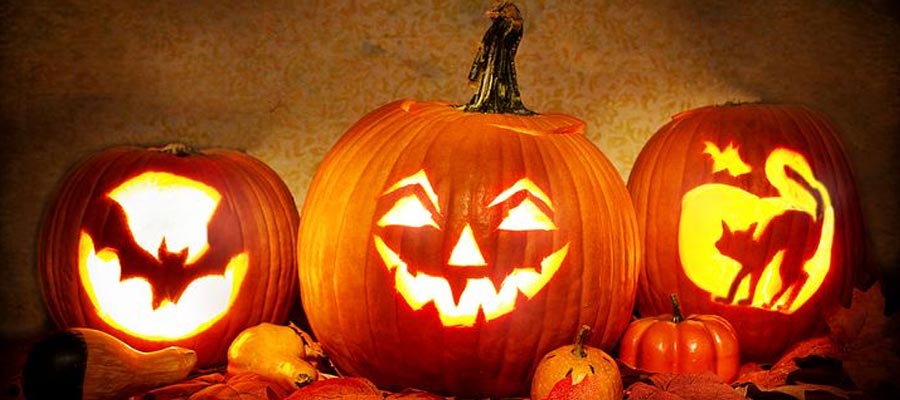Halloween is the second most popular holiday in North America after Christmas. Falling on October 31, it’s a day on which children and even adults dress up in frightening and interesting costumes. Most children go from house to house “trick-or-treating,” which means asking for candy and other treats.
The traditions and activities which we have come to associate with Halloween come from various sources. The name “Halloween” is a shortening of “All Hallows’ Evening” or “All Hallows’ Eve.” It’s the evening before All Saints’ Day. Scholars believe that Halloween first originated with the Celtic festival of Samhain (pronounced “sow-in,” with “sow” rhyming with “cow”). The word comes from the Old Irish “samhuin,” meaning “summer’s end.” For the Celts this was the end of their calendar year. There was also the sense that at this time the physical and supernatural worlds were closest to each other and that magical things could happen.
All Saints’ Day and All Souls’ Day (November 1 and 2) also have had an influence on Halloween. By the end of the 12th century these had become holy days of obligation all over Europe. Traditionally it was believed that the souls of the dead roamed1 the earth until All Saints’ Day. All Hallows’ Eve was the last chance these spirits had to take revenge2 on those who had wronged them while they were alive. After that, the spirits would move on to the next world. Christians then used to walk around that night wearing masks and costumes to disguise themselves3 from the dead. From this arose the habit of wearing a costume on Halloween.
Halloween costumes traditionally copy supernatural creatures such as monsters, witches, skeletons, and devils. In recent times, characters from popular culture have also become costumes.
Trick-or-treating is what children normally do on Halloween. This involves going door to door asking for candy, or sometimes money. Here the word “trick” acts as a light threat4 that the children will perform some mischief5 if the owner of the home doesn’t hand out a “treat.” This custom is like the old Christian tradition of “souling,” when the poor would go from home to home. Homeowners would give them food in return for prayers for the dead on All Souls’ Day.
The creation of “jack-o’-lanterns,” or pumpkins with faces carved onto them, initially came from Ireland and Scotland. To this day, the Scottish and the Irish carve turnips6 into lanterns7 in order to remember the souls in purgatory8 during Halloween. Purgatory is a place between heaven and hell, in which souls wait to see where they’re going to end up. Immigrants to North America used pumpkins instead in the middle of the 19th century. Pumpkins are bigger, softer and easier for carving than turnips.
The purpose of the jack-o’-lantern was to keep away the spirits and ghosts during Samhain. An Irish legend claims that they are so-called because a man named Jack tricked the devil several times.
Therefore he was not allowed to enter either heaven or hell, and he was condemned9 to wander the Earth.
Orange and black are the colors of Halloween. Orange represents the autumn harvest and black darkness and death.
In Ireland and Scotland, children dress up in costume and go “guising10” and have parties. Particularly in Ireland, people light huge fires and have firework displays. In the late 19th century, mass immigration popularized Halloween in North America. In the United States, the first mass-produced Halloween costumes appeared in stores during the 1930’s, when trick-or-treating became popular.
From North America, the influence of Halloween has spread to South America, Australia, New Zealand, continental Europe, Japan, and other parts of East Asia.
Through a mixture of both pagan and Christian traditions Halloween came to be what it is today. It’s a day on which you can pretend to be someone or something else, and go around collecting huge amounts of candy. It’s a holiday associated with fun. On October 31, horror movies are shown on TV, children stuff themselves with sweets, and even adults dress up, trying to shock and scare others.
On Halloween, we try to get close as possible to the line separating life and death. We want to see what thrills and wonders lie beyond our reality.
Prepared by Francis Mejia
Vocabulary 1potulovať sa – bloumat; 2pomstiť sa – pomstit se; 3/disgaiz/ zamaskovať sa, schovať sa – zamaskovat se, schovat se ; 4hrozba – vyhrůžka; 5darebáctvo, neplecha – darebáctví, neplecha; 6repa – tuřín, vodnice; 7/lænt∂n/ lampáš – lucerna; 8/p∂:g∂tri/ očistec; 9odsúdený – odsouzen; 10chodiť v maskách – chodit v maskách

